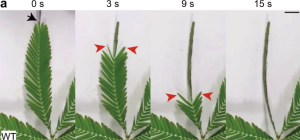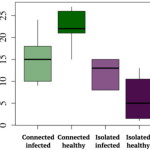Calcium fluxes mediate sensitive plant responses
 Plants that respond to touch, like Mimosa pudica (aka the sensitive plant) are great ways to introduce children to the fascination of plants. If you haven’t had the chance to explore this plant, a touch to a leaflet causes the leaflets to fold into themselves, and recurring touches cause the leaf to drop away. Both responses occur due to a rapid loss of water from critical cells at hinge points. Hagihara et al. introduced into M. pudica an ultrasensitive fluorescent calcium ion (Ca2+) indicator (GCaMP6f) to investigate these fast responses. Wounding elicited a rapid increase in cytosolic calcium that propagated along the vein, indicating that cytosolic calcium ions act as long-distance rapid signals triggering leaf movements (see video). Furthermore, to investigate the evolutionary significance of these movements, they treated plants with a calcium channel blocker (La3+), which interfered with the touch response. These treated plants plants were more susceptible to herbivory by grasshoppers, demonstrating a defensive role for the leaf movements. (Summary by Mary Williams @PlantTeaching) Nature Comms. 10.1038/s41467-022-34106-x
Plants that respond to touch, like Mimosa pudica (aka the sensitive plant) are great ways to introduce children to the fascination of plants. If you haven’t had the chance to explore this plant, a touch to a leaflet causes the leaflets to fold into themselves, and recurring touches cause the leaf to drop away. Both responses occur due to a rapid loss of water from critical cells at hinge points. Hagihara et al. introduced into M. pudica an ultrasensitive fluorescent calcium ion (Ca2+) indicator (GCaMP6f) to investigate these fast responses. Wounding elicited a rapid increase in cytosolic calcium that propagated along the vein, indicating that cytosolic calcium ions act as long-distance rapid signals triggering leaf movements (see video). Furthermore, to investigate the evolutionary significance of these movements, they treated plants with a calcium channel blocker (La3+), which interfered with the touch response. These treated plants plants were more susceptible to herbivory by grasshoppers, demonstrating a defensive role for the leaf movements. (Summary by Mary Williams @PlantTeaching) Nature Comms. 10.1038/s41467-022-34106-x



